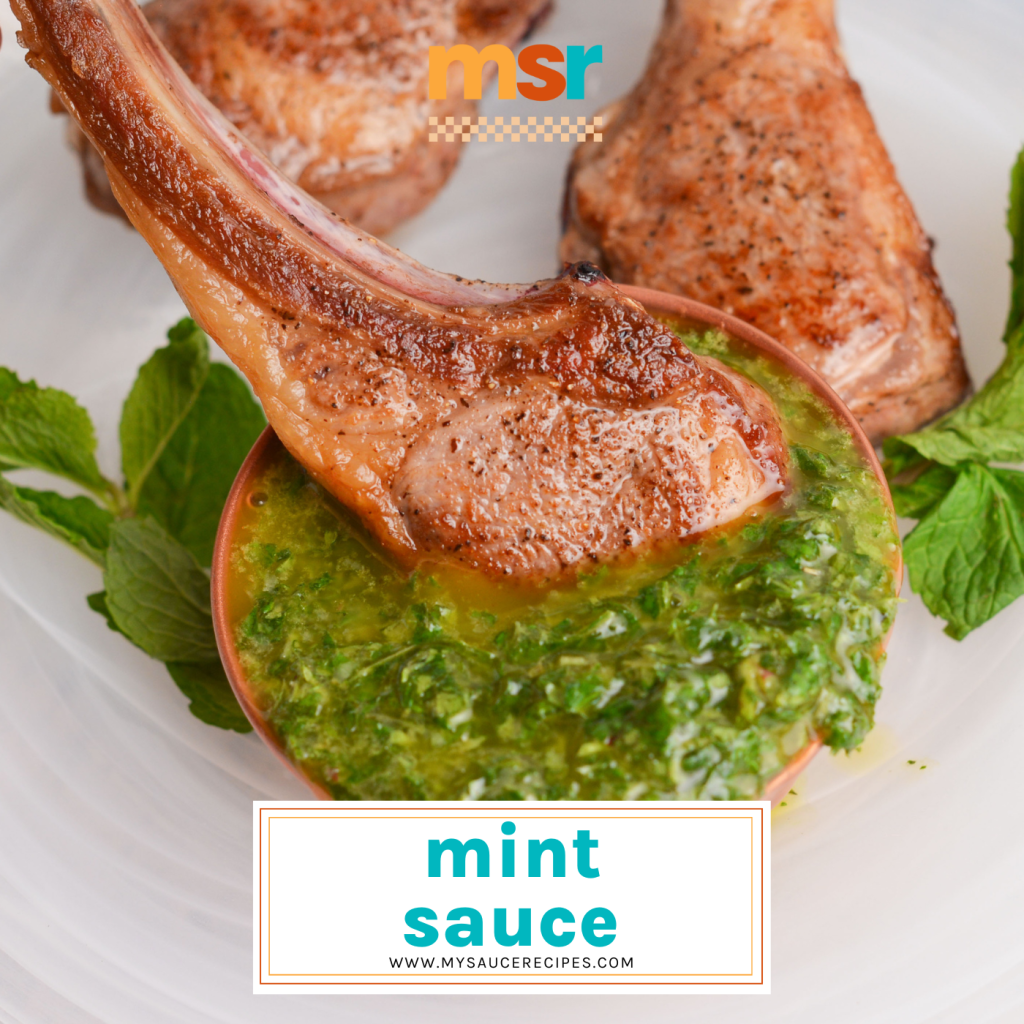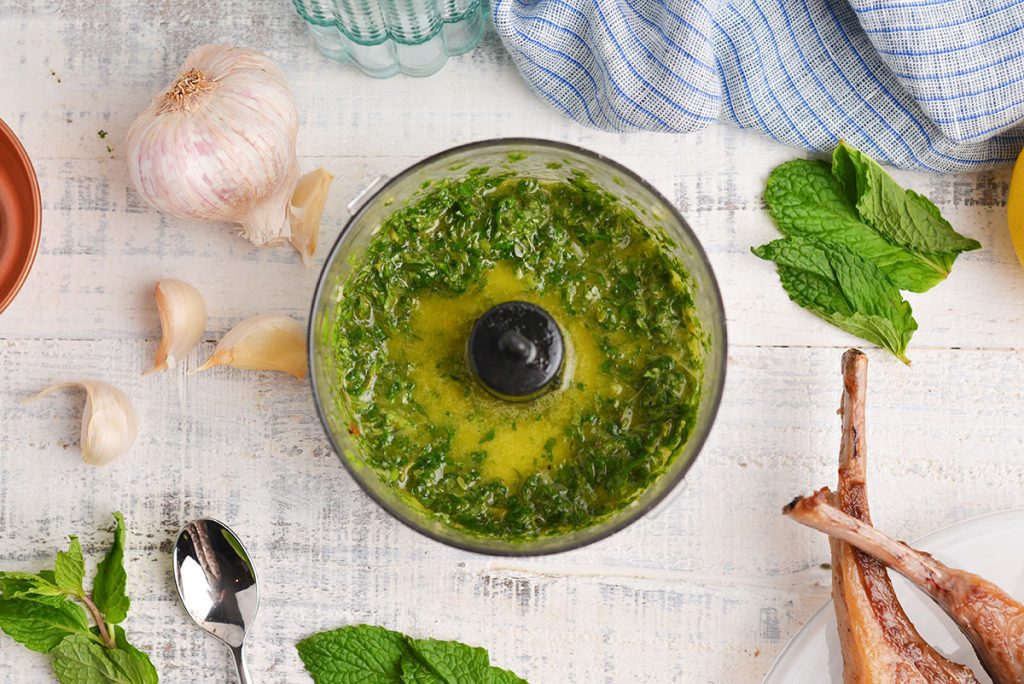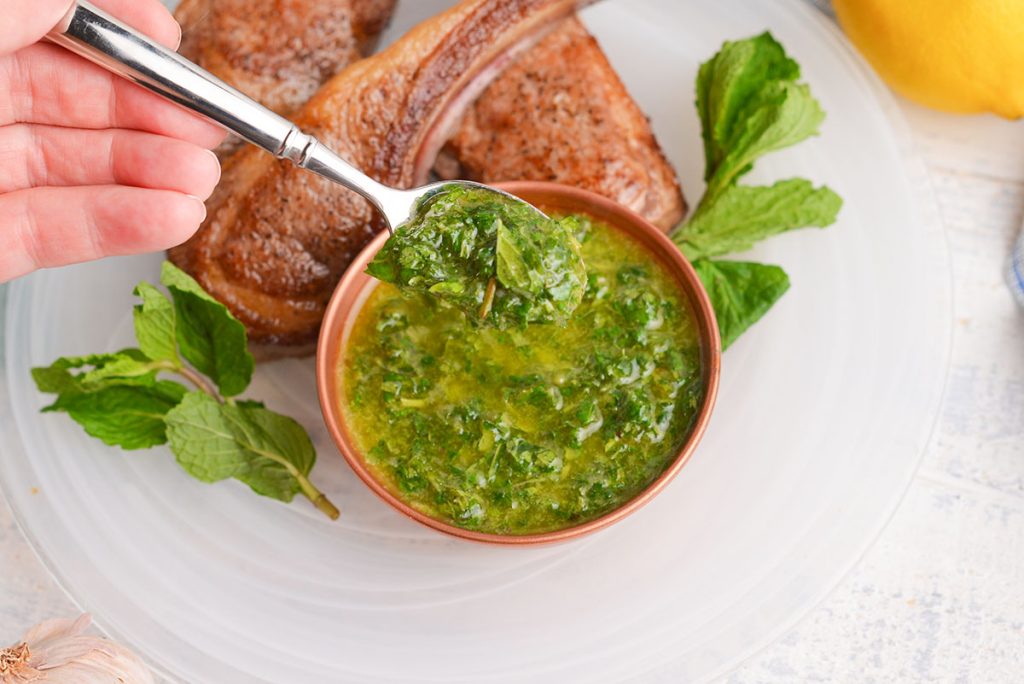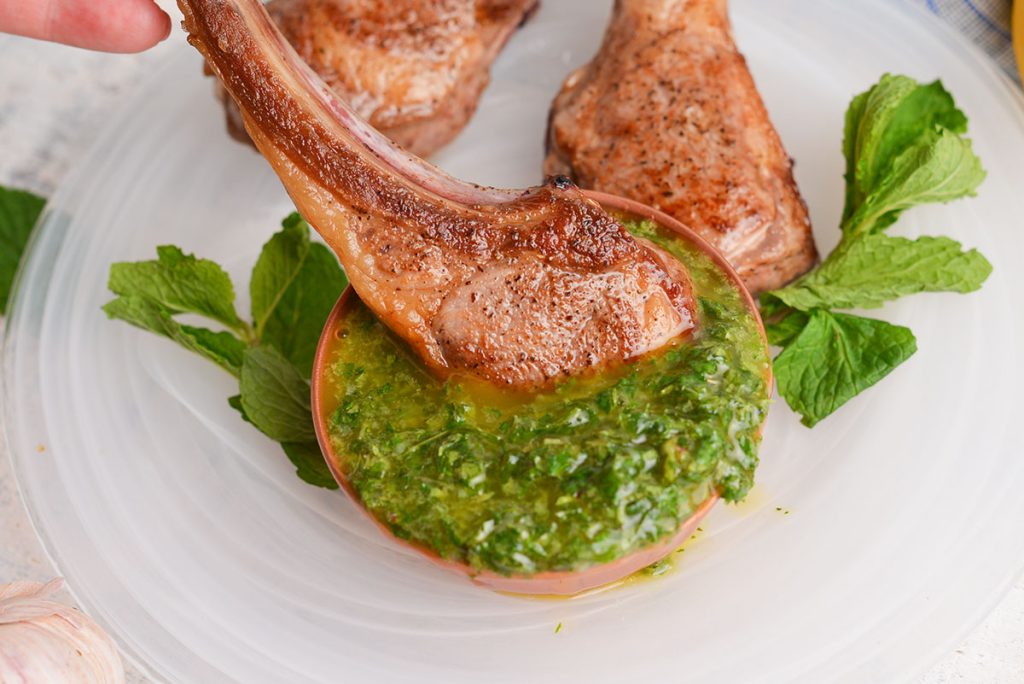A lot of times when I am whipping up a sauce at the last minute for dinner, I’ll fall back on one of my favorite homemade BBQ sauces. However, sometimes I’m looking for something a little lighter and brighter — this homemade mint sauce is just the thing.

There are times of year when I have tons of mint and this is the perfect way to use it. All you have to do is combine it with the vinegar, oil, and a few spices and — voila! — it’s ready to serve.
In addition to being tasty, the sauce is good for you, too, since it uses heart-healthy olive oil. Additionally, mint is touted for helping with anything from indigestion to weight loss and is thought to be an anti-inflammatory, too.
So, the next time you’re craving a light, bright sauce for your meats, veggies, salads, or dipping, check out this easy recipe.

What is Mint Sauce?
Mint sauce is a vibrant mix of fresh mint with oil, vinegar, and a few other simple ingredients. It’s a thin sauce that’s as perfect for dipping as it is for dressing a salad or drizzling over meat or seafood.
Mint sauce originated in England and was most often paired with lamb (which remains a popular pairing). The traditional English mint sauce was served as an acidic ingredient with the lamb in order to offset both its fattiness and gamey flavor.
While most cuts of lamb are significantly less fatty and gamey than when the sauce was created, its flavor profile is still a perfect pairing for lamb. It’s also ideal for any other meat that benefits from an acidic balance against the backdrop of its fat content — steak, roast beef, and pork dishes are just a few that will work well.

Fresh Sauce vs Mint Jelly
In the United States, sweet mint jelly became a popular condiment for lamb in the mid 1900’s when soldiers returned to the US after war. Having consumed the mint sauce with meat overseas, the flavor combination became popular stateside.
However, there are some drastic differences in both flavor and texture of this more traditional sauce and the jelly that Americans began to make.
First, this fresh mint sauce uses vinegar, oil, and garlic which together give it a zesty and savory flavor. It’s also a thin sauce, best poured or spooned over meats and vegetables.
On the other hand, mint jelly is sweet, incorporating significantly more sugar. Also, the jelly relies on pectin or gelatin to impart its gelatinous texture.
While both condiments offer the bright flavor of mint (and both incorporate some sort of acid) if you’re looking for a savory sauce, this freshly made mint sauce is what you’re after!

Ingredients
- Fresh mint leaves – Make sure to use all of those fresh leaves from your garden or the grocery store — they have way more flavor than any packaged product. Also, be sure that the leaves are packed tightly into your measuring cup.
- Extra virgin olive oil – Extra virgin is generally recommended for making salad dressings.
- Apple cider vinegar – While you can use other styles of vinegar, the combination of the sharpness of the vinegar with the sweetness of apples perfectly balances the sauce.
- Garlic – Make sure that the garlic is finely grated or minced to avoid large chunks of it in the sauce.
- Sugar – Just a bit of sugar helps to round out the sauce. Using regular white sugar is perfect — the granules are the ideal size to dissolve quickly when mixing.
- Coarse kosher salt – Using just a pinch of salt that’s high quality will elevate the sauce, but if you don’t have it on hand you can use your typical table salt.

Uses for Mint Sauce
Of course this mint sauce recipe is a great accompaniment to roast lamb, but there are plenty of other ways to use it.
- Salads or rice bowls – Brighten up your standard salad and or rice bowl by drizzling this sauce over top or tossing your protein in it before adding to the bowl.
- Proteins – Use this sauce before cooking as a marinade, or afterwards to finish.
- Pita chips – Brush pita with this sauce prior to baking for flavorful pita chips.
- Rice or pasta – Toss cooked rice or pasta with this for a super easy side dish.
- Pasta salad – Replace your typical Italian dressing with this for an upgraded pasta salad.
- Guacamole – Add this sauce to your avocado and other ingredients for an herbal take on guac.
- Dipping sauce – Dip pita, freshly sliced (or ripped) tortillas, or even baguette slices in this sauce. You can also serve it alongside a cheese/charcuterie selection with the likes of goat cheese, gouda, salami, and pancetta.
- Dip – Mix the mint sauce with dairy for a dip that will brighten up any plate of crudites. Whether it’s a light dip with sour cream or yogurt, or a heavier spread when mixed with the likes of cream cheese, it will be a hit.
- Breakfast – Drizzling this over scrambled or fried eggs or an omelet filled with feta for a zesty start to the day.
- Potatoes – Serve it as a fry sauce, mix it into mashed potatoes, or toss cubed potatoes in it after roasting or frying them.
- Breakfast bagel – If you like lox with your schmear, try adding a layer of this sauce for some zippy morning flavor.
- Soup – Adding mint sauce to soups like ham and pea will add layers of flavor.

Variations
- Oils – Any oil from olive oil or canola oil to grapeseed or sesame oil will work.
- Vinegar – Change up the type of vinegar you use. Try white wine vinegar, distilled white vinegar, or even balsamic vinegar..
- Cream – Simply add this to Greek yogurt or sour cream to taste. If you want something significantly thinner, but still cream-based you can add heavy cream to taste.
- Onion – Try using onion powder or finely diced onions. For added color, you can try slivers of green onions or red onions.
- Heat – For just a little heat try adding a bit of black pepper. For a lot of heat, add crushed red pepper or cayenne.
- Lemon juice – While the mint is what makes the sauce bright, lemon always brings out even more flavor. It also naturally pairs well with mint.
- Indian mint sauce – With just a few simple ingredients like jalapenos, cilantro, ginger, and yogurt you can transform this into a sauce perfect for dipping naan or drizzling over samosas or kabobs.
Storage & Freezing
Store this sauce in an airtight container in the refrigerator for up to a week. Freezing oil-based sauces is not recommended.
If serving after refrigeration, allow the sauce to come to room temperature first.

More Savory Sauces





Fresh Mint Sauce Recipe
Ingredients
- 1/2 cup fresh mint leaves , packed
- 1/2 cup extra virgin olive oil
- 1 tablespoon apple cider vinegar
- 1 clove garlic , grated or minced
- 2 teaspoons sugar
- 1/4 teaspoon coarse kosher salt
Instructions
- Combined the fresh mint, olive oil, vinegar, garlic, sugar and salt in a small food processor. Pulse several times until leaves are coarsely chopped.
- Allow to sit at room temperature for 10-15 minutes and stir well before serving.
- If you've tried this recipe, come back and let us know how it was in the comments or star ratings!

Thank you so much! The flavors are perfect and I can’t wait to try this recipe!
love anything with mint. It sounds like a flavorful recipe. thanks for sharing
I was looking for a mint sauce recipe to go with a roast leg of lamb I was making and the recipe sounded perfect… and it was! I wasn’t sure how the vinegar would work, but this tastes excellent and really delicious. I prefer this much more than mint jelly. I’m keeping this as a standard to go with my leg of lamb dinner. Only thing I needed was to double or triple the recipe as everyone gobbled it up.
Oh yum! This sauce looks so flavorful and vibrant. Definitely the perfect use for leftover mint.
I love this one. The flavors are fantastic, and recipes like this that are so versatile are perfect for the way I cook.
This was fabulous and flavourful! I had a lot of extra mint in my garden and this was a great way to use it up.